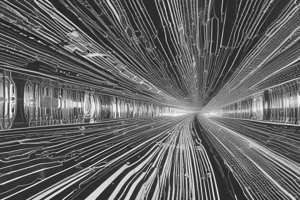Podcast
Questions and Answers
In the context of image processing, what is the main purpose of image enhancement techniques?
In the context of image processing, what is the main purpose of image enhancement techniques?
- To convert images into different file formats.
- To reduce the computational resources required for image analysis.
- To automatically identify and classify objects within an image.
- To improve the visual appearance of an image and make it more suitable for analysis. (correct)
Which of the following is a primary goal of computer vision?
Which of the following is a primary goal of computer vision?
- Enhancing the aesthetic quality of photographs.
- Converting images into different artistic styles.
- Automating tasks that the human visual system can perform. (correct)
- Reducing the file size of image files for efficient storage.
Which of the following tasks is typically considered part of image processing rather than computer vision?
Which of the following tasks is typically considered part of image processing rather than computer vision?
- Noise reduction in a medical X-ray. (correct)
- Autonomous navigation using camera input.
- Facial recognition in a video stream.
- Object detection in an image.
What role does feature extraction play in the relationship between image processing and computer vision?
What role does feature extraction play in the relationship between image processing and computer vision?
Which of the following statements accurately describes the relationship between image processing and computer vision?
Which of the following statements accurately describes the relationship between image processing and computer vision?
What is a key difference between spatial domain methods and frequency domain methods in image processing?
What is a key difference between spatial domain methods and frequency domain methods in image processing?
In computer vision, what is the purpose of image segmentation?
In computer vision, what is the purpose of image segmentation?
Which of the following applications primarily utilizes computer vision techniques?
Which of the following applications primarily utilizes computer vision techniques?
What is the role of Convolutional Neural Networks (CNNs) in computer vision?
What is the role of Convolutional Neural Networks (CNNs) in computer vision?
You have a task that requires identifying different types of cells in microscopic images. Which field is MOST directly applicable?
You have a task that requires identifying different types of cells in microscopic images. Which field is MOST directly applicable?
Flashcards
Computer Vision
Computer Vision
A field of AI enabling computers to interpret images, automating tasks of human vision, involving acquisition, processing, and analysis of images.
Feature Extraction
Feature Extraction
Identifying relevant features in an image, such as edges, corners, and textures, for further analysis in computer vision.
Image Classification
Image Classification
Assigning a label to an entire image based on its content, a fundamental task in computer vision.
Object Detection
Object Detection
Signup and view all the flashcards
Image Segmentation
Image Segmentation
Signup and view all the flashcards
Image Processing
Image Processing
Signup and view all the flashcards
Image Enhancement
Image Enhancement
Signup and view all the flashcards
Image Restoration
Image Restoration
Signup and view all the flashcards
Image Compression
Image Compression
Signup and view all the flashcards
Image Filtering
Image Filtering
Signup and view all the flashcards
Study Notes
Computer Vision
- Computer vision is a subfield of AI enabling computers to interpret images, mimicking human vision.
- The objective is automating tasks achievable by the human visual system.
- The process includes image acquisition, processing, analysis, and comprehension.
- Image recognition, object detection, and scene understanding stand as the primary goals.
- Machine learning and deep learning algorithms are leveraged to extract image insights.
- Applications span various domains, including:
- Detecting objects in images and videos
- Image classification and recognition
- Image segmentation
- Facial recognition
- Enabling autonomous driving
- Analyzing medical images
- Creating augmented reality experiences
- Enhancing robotics
- Core concepts are:
- Feature extraction identifies key image elements like edges, corners, and textures
- Image classification assigns labels based on content
- Object detection locates specific objects
- Image segmentation divides images into meaningful regions
- Pattern recognition identifies image regularities
- Convolutional neural networks (CNNs) are frequently employed in computer vision for image analysis
- Datasets such as ImageNet are critical in the training, evaluation, and benchmarking of computer vision models.
Image Processing
- Image processing involves image manipulation and analysis for quality enhancement or information extraction.
- Relative to computer vision, it is a lower-level process.
- The emphasis is on transforming images, accentuating features, and readying them for more in-depth analysis.
- Common techniques include:
- Image enhancement refines visual quality using methods like contrast stretching and histogram equalization
- Image restoration minimizes noise and artifacts
- Image segmentation partitions images into regions, often at the pixel level based on color or intensity
- Image compression reduces the storage size required for images
- Image filtering modifies or enhances image features such as blurring or sharpening
- Morphological operations change object shapes and structures using techniques like erosion and dilation
- Image processing modifies images at the pixel level.
- Image processing serves as a pre-processing stage for computer vision, aiming to improve input image quality.
- OpenCV provides many image processing utilities.
- Applications for image processing include:
- Enhancing medical images like X-rays and MRIs
- Correcting distortions in satellite images
- Adjusting brightness, contrast, and color in photography
- Improving surveillance footage in security contexts
- Key concepts encompass:
- Spatial domain methods directly manipulate image pixels
- Frequency domain methods transform images using Fourier transforms for filtering
Differences and Relationships
- Image processing is a subset of computer vision.
- Tools to manipulate and enhance images are provided, while computer vision interprets image content.
- The focus of image processing is manipulating images while computer vision focuses on extracting meaning.
- Image processing is a pre-processing step to improve the quality of images.
- Computer vision systems usually need more complex algorithms and computational resources than image processing.
- Examples of:
- Image processing: Noise reduction
- Computer vision: Identifying objects
- Image processing: Enhancing image contrast
- Computer vision: Recognizing faces
- Mathematical and statistical techniques for image analysis are used in both fields.
- Feature extraction bridges image processing and computer vision by using processed image data to identify features for vision tasks.
Studying That Suits You
Use AI to generate personalized quizzes and flashcards to suit your learning preferences.




